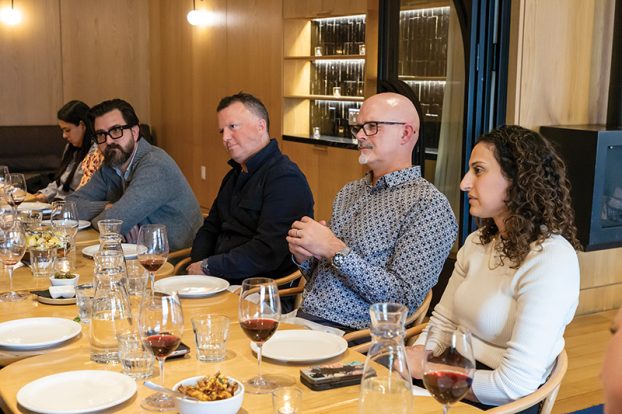Are you ready for Rice Krispies World? How about Burger King Monthly? Or BiWay Life?
Well, don’t get excited. None of these is coming down the pike just yet (so far as we know, anyway). But the possibility has begun to seem less and less implausible all the time.
The idea of advertisers creating their own customized magazines, generally in partnership with a publisher, is far from newly-minted. But the recent appearance of such slick new entries as Avon’s Confidante and President’s Choice Magazine from Loblaws suggests that this business of contract publishing is growing ever more sophisticated.
Books like these work hard to avoid the ‘glorified brochure’ label typically attached to such publications in the past. They strive to present editorial that appears credible and objective, and sell space to non-competing advertisers in an effort to heighten the resemblance to ‘real’ magazines.
Obviously, the current health of the economy is one of the reasons some fairly major players have gotten into the game lately. (Contract publishing is, after all, an expensive venture.) And, of course, there’s the appeal of being able to communicate to consumers on your own turf, without having to battle countless competitors for attention out in the noise-ridden mass media arena.
In this feature, written by David Todd, Strategy takes a look at four of the newest such publications. Among the questions it addresses are what thinking led to their creation, and what attracts outside advertisers to them.
Sympatico NetLife
Barbara Warren has a few simple words of advice for any company that thinks a glossy contract publication is just the vehicle for communicating to its customers.
You’d better be talking to readers about more than just your own goods and services, she says. Otherwise they’ll round-file your slick pseudo-magazine faster than you can say ‘shameless self-promotion.’
‘Contract publishing can fly right in your face if you do nothing but talk about yourself,’ argues Warren, associate publisher and national sales manager of Sympatico NetLife, a bi-monthly magazine produced jointly by Telemedia Publishing and MediaLinx Interactive, and distributed to all members of the Sympatico on-line service.
‘It’s not going to strengthen your relationship with the customer if it’s just a beautiful brochure with no meat inside. That’s not adding value for consumers. But if you’re giving them relevant information about their hobbies, passions and interests, they’re going to love you for it.’
That kind of love-in is precisely what Sympatico NetLife has been aiming for since its launch in the fall of 1996. Warren says it was understood from the outset that the magazine had to be more than ‘a self-stroking brochure’ promoting the glories of the Sympatico service. (Sympatico was founded by Medialinx in concert with telecommunications providers across the country.)
Instead, she says, the magazine attempts to add value for Sympatico subscribers, by assisting them in the search for valuable content on the World Wide Web, and helping to make the Internet easier for them to use.
‘It’s definitely a relationship-builder,’ Warren says. ‘It’s adding to the sense of community that Sympatico is creating.’
Sympatico NetLife started with a circulation of 80,000, and has just recently crossed the 300,000 threshold. (In addition to going to Sympatico members, the magazine is sold on newsstands across the country.) Warren says the audience consists primarily of ‘second-wave’ users – folks who aren’t technologically savvy, and who need help in making more enjoyable and productive use of their on-line time.
Because the magazine’s audience is, by definition, just about 100% wired, NetLife has been something of a magnet for technology advertisers such as Hewlett-Packard and IBM Canada. Increasingly, however, the publication has been attracting interest from advertisers in more mainstream categories, such as automotive and alcoholic beverages.
Toyota Canada, for example, has advertised its ’98 Corolla in the pages of Sympatico NetLife. Ross Campbell, associate media director with Toronto-based Saatchi & Saatchi, which handles the Toyota account, says there was a logical fit.
‘Their audience includes a lot of upscale families with children, which is one of our targets on Corolla,’ he says. ‘And when we look at the Corolla owner, there’s definitely a trend towards being connected to the Internet.’
Warren says the magazine can also take advantage of its Sympatico tie when approaching advertisers. NetLife will, she says, work to create integrated, multi-media buys for interested advertisers, incorporating both the print publication and the Sympatico service itself.
Sympatico NetLife, says Warren, enjoys the advantage of having come along just as the demand for such a magazine – whether a contract publication or not – began to take off.
‘There’s a real need out there for something that delivers friendly, helpful information about the Web,’ she says. ‘That’s why I think we’ve been so widely embraced.’
President’s Choice Magazine
On one level, there’s really not much difference between President’s Choice Magazine and President’s Choice Memories of Kashmir Tandoori Sauce.
True, only one of these can be used to form the basis of a tasty marinade. But that’s less important than what they share in common – namely, the fact that both are products under the President’s Choice banner, sold in Loblaws-affiliated supermarkets across Canada.
For publisher Jack McIver, that’s an important point to emphasize. ‘This is a private-label magazine,’ he says. ‘It’s not a brochure or a catalogue. It’s not a magazine about President’s Choice. It’s a President’s Choice magazine. There’s a real distinction. This is a President’s Choice product that just happens to be a magazine.’
The first issue of the publication, which has a circulation of 125,000, went on sale Feb. 26. McIver says consumer response was immediate and enthusiastic: It sold out in several stores in the first week, and in Ontario had a 75% sell-through after less than two weeks.
President’s Choice Magazine is produced by Toronto-based Zaxis Publishing, under contract to Loblaws. McIver, who is president of Zaxis, says the inspiration came from a similar publication produced on behalf of the Sainsbury’s grocery chain in the u.k. Zaxis brought the concept to Loblaws three years ago, and has been working on development of the publication ever since.
While the largest portion of the editorial content is devoted to food and cooking, the magazine – which is to be published 10 times a year – also devotes space to home decor, health and fitness, fashion, travel and other lifestyle issues.
For Loblaws, McIver says, President’s Choice Magazine serves mainly as an image-builder. ‘It enables them to strengthen their relationship with customers, and to enhance their reputation as a retailer that understands about good food, cooking and entertaining.’
Under the terms of the agreement with Zaxis, Loblaws has two pages of advertising in every issue. The magazine also includes a page of coupons redeemable at Loblaws stores, and a feature called ‘Shop Talk’ that highlights President’s Choice products. But McIver is quick to note that there’s no mandate to promote pc-brand goods in the editorial.
From the outset it was agreed that, in keeping with its status as a ‘genuine’ consumer book, President’s Choice Magazine should support itself through the sale of advertising.
More than 30 advertisers signed on for the first issue. While manufacturers and distributors of food products, such as Quaker Oats and Nescafe, make up the largest single category, McIver says the publication has succeeded in attracting a remarkably diverse range – from Holt Renfrew, to Range Rover, to investment advisors kpmg.
What’s the attraction for them? The desirability of the audience, for a start, says McIver – affluent, well-educated consumers, most of them aged 30-50. To say nothing of the oversized format and high production values, which inevitably heighten the appeal of the magazine as an environment for advertisers targeting an upscale crowd.
Research prior to the launch of President’s Choice Magazine suggested that Loblaws customers were favorably disposed to the idea of such a publication. Now that the idea is a reality, it’s clear that they were telling the truth. And that, says McIver, is the story the magazine will be taking to advertisers.
‘There’s a really good buzz about the magazine,’ he says. ‘People see that we’ve delivered the goods.’
Confidante
Don’t think of it as a magazine; think of it as a best friend.
That, in broad terms, is the message Avon Canada is trying to send out to the readers of Confidante, the glossy new publication that the Montreal-based beauty products manufacturer launched in February.
According to Lucie Brodeur, Avon product publicity manager, the idea for Confidante is one that had been simmering on the corporate back burner for some years.
Avon already publishes a brochure every three weeks, through which it sells its cosmetics, fragrances and other product lines. But Brodeur says the company was looking for a means of entering into a more intimate dialogue with its customers.
The company partnered with Toronto-based Multi-Vision Publishing to produce Confidante, which itself is sold through the Avon brochure, in both English and French editions. The first 100-page issue has a circulation of 300,000 copies.
While the primary focus of the publication, which targets mainly women 35-54, is on beauty and fashion, the content also includes food, health, fitness and other lifestyle issues.
‘It’s an all-encompassing magazine,’ says Mary Jakob, vice-president, marketing with Multi-Vision and publisher of Confidante. ‘The positioning for the publication is that it should become an intimate best friend – a confidante. Something that can help women feel good about themselves. And there’s more to feeling good than just fashion or beauty.’
Avon has taken a hands-off approach with respect to content, Jakob adds, and has resisted the temptation to include references to Avon products in the editorial.
Brodeur, for her part, says that’s in keeping with Avon’s goals for the publication. Confidante, she explains, was created not to push product, but rather to add value for customers and to help build brand image.
Admittedly, Avon does own the lion’s share of the advertising space in the book – some 20 of 30 pages, all told. But Brodeur says they also made a point of bringing outside advertisers, such as Clairol Canada, Chevrolet and Five Roses flour, into the publication. In addition to generating revenue, she says, the presence of other advertisers lends added credibility to the magazine.
Aside from being relevant to Confidante’s readership, prospective advertisers obviously had to be non-competing. That made the search somewhat of a challenge, since Avon sells products in such a wide variety of categories – not just cosmetics, but also clothing, books and vitamins.
And just what does the magazine have to offer outside advertisers? Well, apart from competitive rates, there’s the relative purity of the environment, says Brodeur. Because ad space is quite limited, there’s much less clutter than in the average women’s service book.
Ailsa MacLachlan, group media director with McKim Media Group in Toronto, says it was the ‘exclusivity’ of the environment that made Confidante a reasonable buy for her client Clairol.
MacLachlan has dealt with contract publications such as Confidante on a number of occasions, and has found them to be useful vehicles – although they rarely offer the same kind of research on their readership as mainstream magazines.
The second issue of Confidante is scheduled for publication in September. While the magazine will continue to pursue outside advertisers, the current editorial-to-advertising split of 70-30 will remain unchanged, Brodeur says.
‘There’s never going to be more advertising than that,’ she insists. ‘Because that would defeat the primary purpose of this magazine, which is to talk to our customers.’
harry
Meet harry. harry knows a thing or two about dressing well. And if you’ve got a few minutes, harry would like to share a little of his wisdom with you.
harry, the upscale magazine created by Toronto-based haberdasher Harry Rosen, was launched with much fanfare in the fall, promising insight and advice on the finer points of men’s fashion. The second issue made its appearance last month.
Larry Rosen, president of the company and publisher of harry, says the magazine arose from the ashes of the retailer’s twice-yearly catalogue, The Report on Menswear, which was discontinued a year and half ago when it became clear that the concept had grown ‘stale.’
Harry Rosen himself, executive chairman of the retail chain and Larry’s father, had for some time been lamenting the absence of a publication in the Canadian market that talks intelligently to men about apparel and lifestyle. So it was decided that the Harry Rosen company would take upon itself the task of filling that gap.
‘If we have a reputation, it’s as experts in quality menswear,’ says Larry Rosen. ‘We felt we wanted a vehicle that would enable us to speak to our customers about the subject, and reaffirm their view of us.’
The retailer has developed harry in concert with its ad agency-of-record Roche Macaulay & Partners Advertising, and design specialists Concrete Design Communications of Toronto. From a marketing point of view, Rosen says, the goal is to keep Harry Rosen top of mind as a retail destination and to help build the brand, without being too overtly promotional in tone.
‘As an advertising tool, it’s longer-term and more subtle,’ Rosen says. ‘If you talk intelligently to people about things that interest them, and reinforce in their minds that you’ve got expertise, then eventually they’ll pay back the respect you’ve shown them.’
The editorial team is essentially independent, Rosen says. Aside from providing guidance, to ensure that the magazine does communicate intelligently to its readership, Harry Rosen has largely removed itself from the editorial process.
The magazine is distributed through direct mail to Harry Rosen’s top 70,000 customers – individuals who have, on average, spent a minimum of $3,000-$4,000 in the store within the last two years. Copies are also sold for $6 on ‘quality’ newsstands across the country, and a few are given away at special in-store events.
Of harry’s 100-odd pages, approximately 30 are advertising. In addition to makers of men’s apparel, such as Hugo Boss, Giorgio Armani and Versace, the publication has attracted the likes of Mercedes-Benz, Motorola, Smirnoff and Rolex.
Rosen says the decision to pursue outside advertisers was driven in part by a desire to lend the magazine added credibility.
A couple of simple criteria determine the choice of prospects. Apparel ads must be for lines carried in at least some Harry Rosen stores. And any non-apparel ads must be appropriate to a more upscale publication.
‘We’ve tried to keep the advertising consistent with our target, which is the quality-oriented male consumer,’ says Rosen.
For advertisers interested in reaching that target, he adds, harry is one of the purest vehicles available, by virtue of its direct mail distribution.
It could also be argued that there is a benefit in associating oneself with a brand as strong as Harry Rosen. The name, after all, connotes quality, Rosen says. And that connotation is likely to rub off on advertisers in the book.
One of the happier consequences of pursuing advertising for harry, Rosen says, has been the opportunity to forge new relationships. In a number of cases, he says, the sale of an ad has led to further discussions with the company in question about the possibility of collaborating on promotional efforts.
‘We’ve gone beyond just selling an ad and started talking about how we can work together on projects to communicate more effectively to customers. It has created some alliances that I’m very proud of.’
Also in this special feature:
– Mags going the extra mile: Sponsorships, custom advertorial abound p.21























